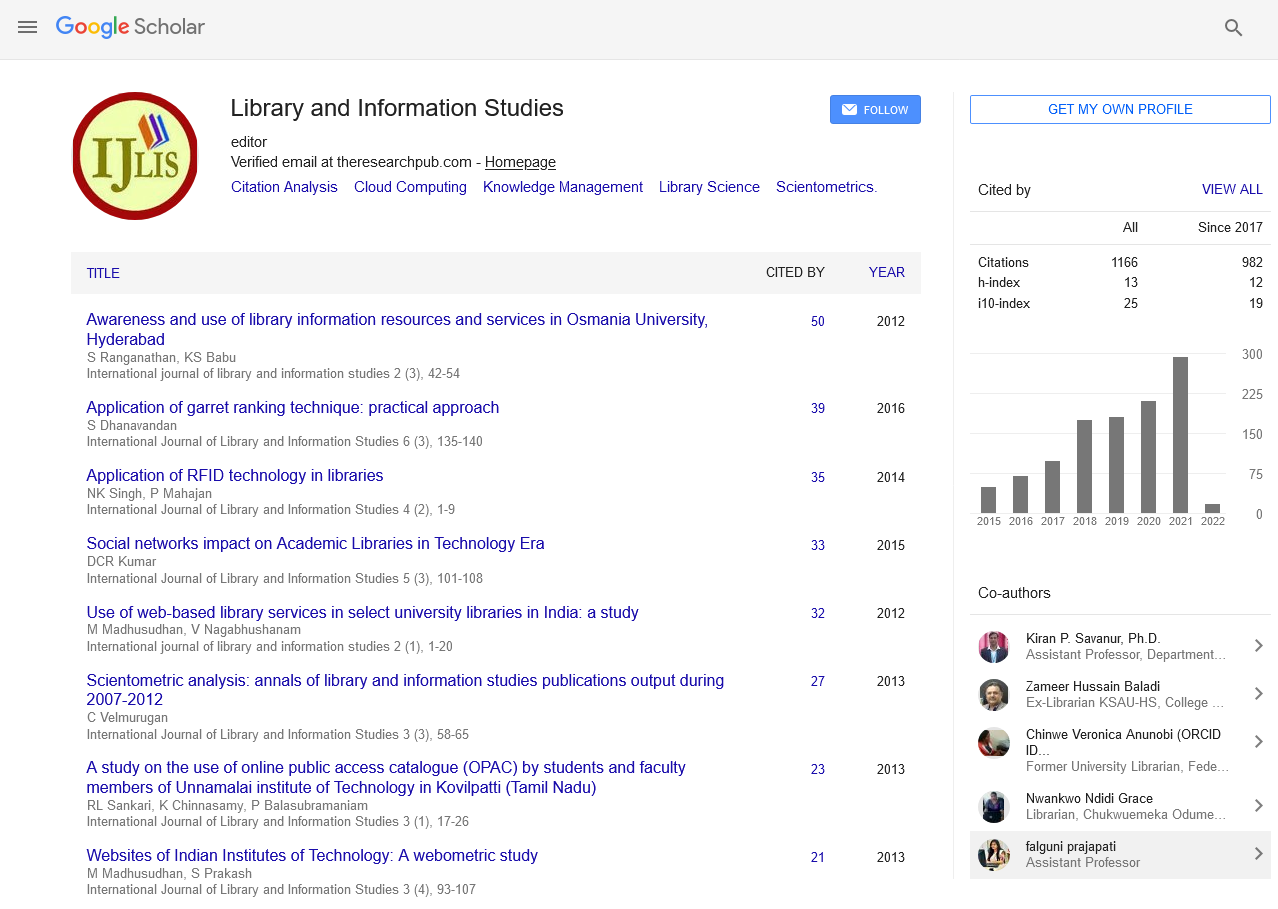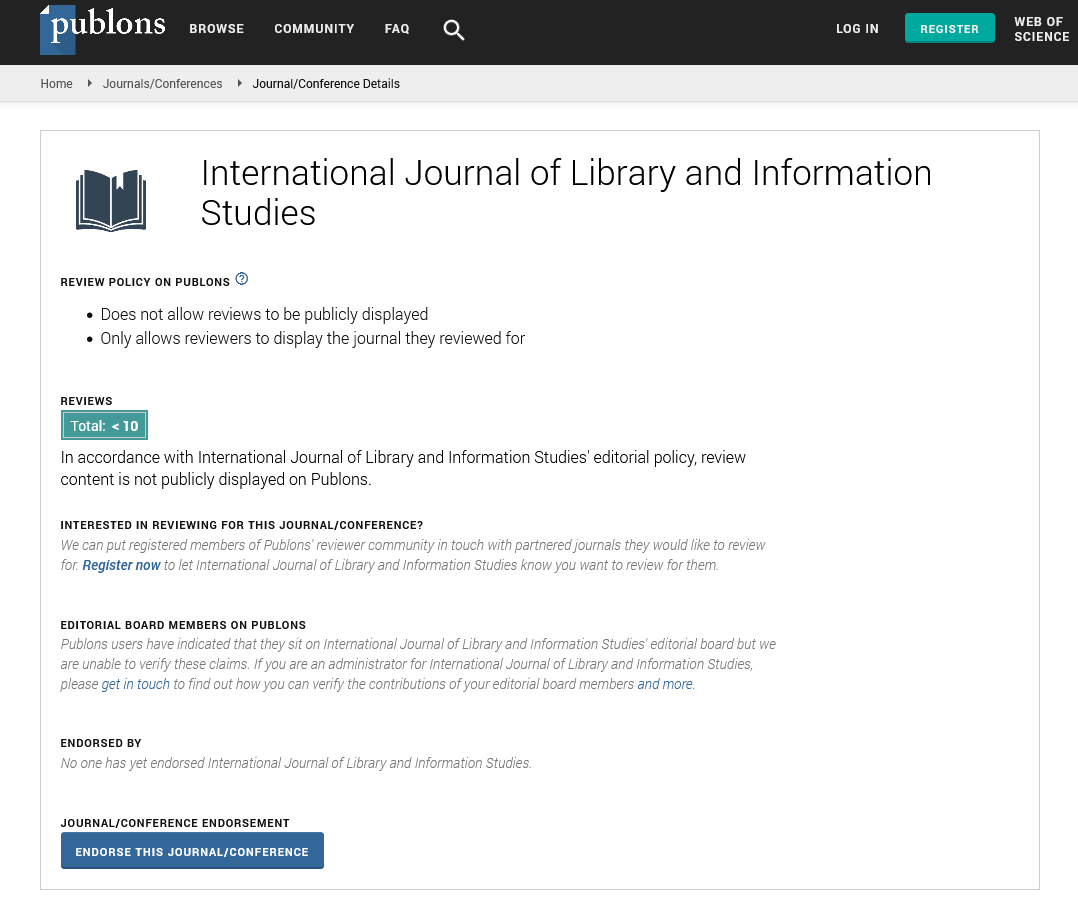Research - (2022) Volume 12, Issue 4
A Study on the Attitude of Postgraduate Commerce Students toward the Library at Poorna Prajna College, Udupi
C. Prema1*Abstract
The study investigates the attitude of Postgraduates commerce students of Poorna Prajna college toward using library resources and services available in their library. The objective of the study is to determine the interest of postgraduate students in the library to hunt for knowledge. A total of 125 questionnaires were distributed among the students, out of which 110(88%) respondents returned the questionnaires with high accuracy rates. The survey method was followed to collect the questionnaires. The collected data were interpreted, analyzed, and tabulated using a statistical package for the method of the social sciences. From the user's point of view, textbooks are essential library resources. They give more importance to printed books rather than eresources. The findings of the study depict that most postgraduate students are satisfied with the resources and services available in their library. The users opined that regular training programs should be provided to the students about using online resources and N-list facilities available in the library. It is the duty of librarians to encourage users to use library resources and provide proper guidance in using online resources
Keywords
Information Centre, Academic Libraries, Students, E-Resources.
Introduction
The Library and Information Centre is a collection of the Powerhouse of Knowledge. The growth of ICT has accelerated the ratio at which information is generated. But, the use of these resources depends upon the skills and capabilities of the users. Users should know how to use both print and online information resources equally and satisfactorily in the library. In this way, the researchers should study library users' various aspects and requirements. In the view of Joseph T. "high-quality information that is created in various parts of the world could be brought under an umbrella, for the convenience of sharpening the ideas which could be made into meaningful products, which will change the way the world thinks about concepts in life." The effectiveness of any information service can be measured by the degree to which its resources are utilized and the extent to which the services meet the information needs of its users” (Kaushamalika & Weerakoon, 2020).
Academic libraries are rapidly supporting and encouraging the acceptance of new forms of teaching and learning exercises (Adithya and others, 2016). Academic libraries may have to implement a more planned way to construct and deliver information services to the users. In a college library, there are various types of users like students, faculty members, and research scholars. The present study is conducted with the purpose to find out the attitude of commerce students of the PG department towards the use of library resources and services in Poorna Prajna College, Udupi.
Review of Literature
Chayal and Lalitha in the year 2021 jointly surveyed a study about information-seeking behavior and satisfaction level regarding library resources of postgraduate students of the University of Rajasthan, Jaipur (Chayal & Lalitha, 2021). The findings of the study reveal that majority of the students visited the library to borrow books and a few percent of the students visit the library for accessing E-Resources. A further study depicted that majority of responders were very satisfied with the collection of newspapers and dissatisfied with eresources collections. The study recommended the subscription of more need-based EResources and conducting user awareness/educational programs for efficient utilization of library resources and services (De Groote, 2021).
Kaur and Kiran jointly studied in the year 2022 that Libraries must provide supportive environments and unhindered services to their users to support their academic well-being (Kaur & Kiran, 2022). A survey of 202 Punjab Agricultural University Library users was conducted to determine users’ satisfaction with the library webpage, library resources, infrastructure facilities, and library services (Kumari, et al., 2016). The study found differences in the satisfaction level and awareness of library services and facilities among undergraduate, graduate, research scholars, and, faculty users (Kaushamalika & Weerakoon, 2020).
Hari Lakshmi and Surendra Babu conducted a joint study in 2017 to collect data on the use of library sources and services among M.C.A. Students at Sri Venkateshwara University, Tirupati. The study findings reveal that users are delighted with the borrowing facility and the library's availability of textbooks, reference books, and e-resources (Hari Lakshmi & Surendra Babu, 2017).
Naik studied in the year 2020 the effective use of library resources and services by the PG students of Bangalore University Library, Bengaluru. The major objective of this study is to find out the utilization of library resources and services by PG students with special reference to Science Department students. The results show that the PG students are satisfied with library resources and services offered by the Bangalore University library and suggested that the library needs to acquire the latest collections of reference books (Jayarama Naik, 2020).
Manjunatha and Sadhashivappa surveyed the user’s satisfaction with library resources and services in B.Ed college libraries in the Hangal district. The findings of the study show that the majority of the students visit the library for borrowing library books and to read materials in their specific subjects. The users are satisfied with newspaper clipping services provided by their library (Ningoji, et al., 2020).
Nayak and Lohar (2019) conducted a study that analyses the users’ attitudes toward library resources and services of First Grade colleges in Davangere city, Karnataka. The main objective of the study is to find out the awareness and use of library resources and services. The findings depict that the majority of students are satisfied with the space for reading room facilities available in their library. The suggestion was given by the investigator that library collection and other operations must be computerized to meet the users’ needs quickly and promptly (Naik & Lohar, 2019).
Profile of Poorna Prajna College, Udupi
Poorna Prajna College is one of the educational institutions run by the Udupi Sri Admar Mutt Education Council, formerly headed by H. H. Sri Sri Sri Vibudhesha Theertha Swamiji of Sri Admar Mutt. Now, the Council is functioning under the leadership of H. H. Sri Sri Sri Vishwapriya Theertha Swamiji of Sri Admar Mutt. Poorna Prajna College, popular as PPC, is situated on a vast green campus in the heart of Udupi city. The College Library is housed in a spacious, well-furnished two-storied building with a reading room facility. There are well over 45,000 volumes of the most recent publications on various subjects. More than a hundred periodicals are made available to students for premise use. The book bank lends volumes to deserving students that they can retain until their examinations. In addition to the main library, departmental libraries are accessible to students (Partap, et al., 2021).
Users
This study is to scientifically observe the use of library resources and services for PG students of Poorna Prajna College library in Udupi. The specific objectives of the study are:
• To determine the purpose of visiting the library by the postgraduate students;
• To study the use of library resources and services by postgraduate students;
• To determine the level of satisfaction of users toward library resources and services;
• To identify the problems faced by users while accessing library resources;
• To offer better suggestions regarding the better use of library resources.
Research Methodology
Keeping in view the objectives, a survey method was adopted, and prepared a structured questionnaire and distributed among the students of Poorna Prajna College, Udupi. A total of 125 questionnaires were distributed among the PG commerce students, out of which 110 (88%) respondents returned the questionnaires with high accuracy rates. The collected data has been interpreted, analyzed, and tabulated using statistical methods. The Institution is no doubt a center of excellence. It's a pride to have a highly qualified and talented teaching faculty working for the well-being of the wards. The Institute enables the students to develop themselves competent and socially responsible, by paving the way for a student-centric approach and atmosphere.
Results and Discussion
Interpretation of data
The data was collected through a structured questionnaire, analyzed, and presented in a tabular form.
Gender-wise distribution of responses
Figure 1 represents the gender-wise distribution of the responses. It is observed that female respondents (62%) are more in comparison to the male counterparts (38%) (Figure 1).
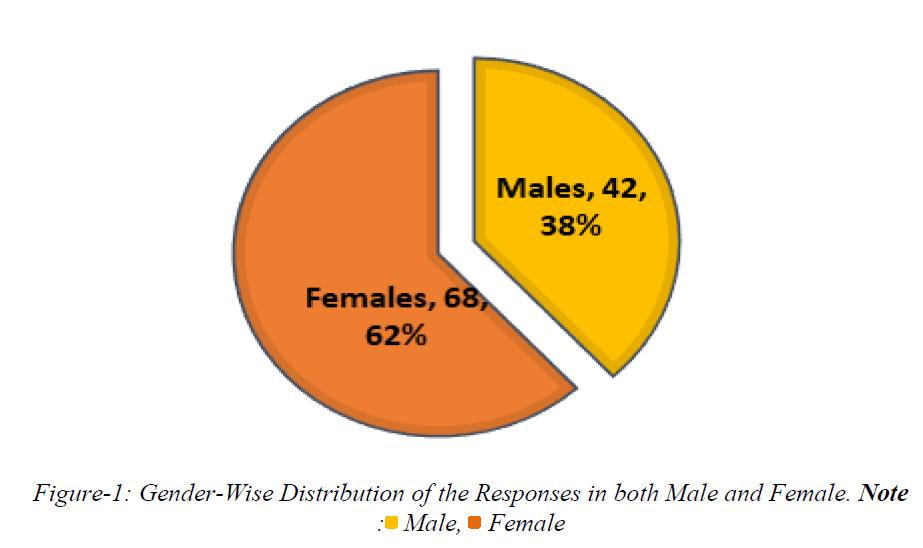
Figure-1: Gender-Wise Distribution of the Responses in both Male and Female. Note
:  Male,
Male,  Female
Female
Frequency of library visits
Frequency is the number of times one can visit the library within a stipulated time. The respondents were asked how frequently they visited the library to study the regularity of inlibrary use, and their responses are represented in Table 1. The above table shows that a maximum (31.8%) of respondents visit the library daily, followed by 20.9% visiting the library twice a week. Only 7.3% of the respondents visit the library occasionally (Table 1).
| Frequency | No. of respondents (Total=110) | Percentage (%) |
|---|---|---|
| Daily | 35 | 31.8 |
| Once in two days | 23 | 20.9 |
| Twice a week | 17 | 15.5 |
| Once a week | 27 | 24.5 |
| Occasionally | 8 | 7.3 |
| Total | 110 | 100 |
Table 1: Frequency of Library Visits by the Respondents
Purpose of library visit to the respondents
The students visit the library with a definite purpose behind it. The above table shows that 94.5% of respondents visit to borrow books and other reading materials, followed by 80.9% of the students who visit the library to read newspapers and magazines stands second in the rank. preparing notes for their exam is 52.7%, and 40.9% of the student's purpose is to access eresources from the library. Only a few percent (17.3) of the respondents replied that they visited the library to write research articles (Tables 2 and 3).
| Purpose of the visit | Responses (N=110) | Percentage (%) | Ranking |
|---|---|---|---|
| Borrow books and other reading materials | 104 | 94.5 | 1 |
| Read newspapers and periodicals | 89 | 80.9 | 2 |
| Prepare notes | 58 | 52.7 | 3 |
| Access E-resources | 45 | 40.9 | 4 |
| Write research article | 19 | 17.3 | 5 |
Table 2: Purpose of Library Visit to the Respondents
Library resource locating strategy
Library resources are necessary sources for any kind of educational activity. The students were queried to state their preferred library resource-finding strategy, and the replies are shown in Table 3. In this table, more than 85% of the students pursue the assistance of the library staff for locating required information, followed by guide boards for 63.6%. Students take help from a lecture 61.8% and 42.7% of respondents who prefer OPAC (Online Public Access Catalogue) as their preferred source for locating library resources (Table 3).
| Methods | Responses | Percentage (%) | Ranking |
|---|---|---|---|
| (N=110) | |||
| With the assistance of library staff | 95 | 86.4 | 1 |
| Through guide boards | 70 | 63.6 | 2 |
| With the help of lecturers | 68 | 61.8 | 3 |
| Through OPAC | 47 | 42.7 | 4 |
Table 3: Library Resources Locating Strategy
Importance of library resources
Various library resources are essential for academic activities. The opinions on the importance of information resources were collected from the respondents, and responses are presented in Table 4. The study reveals that textbooks are more essential library resources (78.2%) than reference books (50%). In the most important category, old question papers stand second (61.8%) and newspapers and magazines (28.2%). Journals come under third place (22.7%) than E-Journals (12.7%) and E-Books (8.2%). In the important category, Newspapers and Magazines stand first, and E-journals come next to newspapers. A few percent of the users opined that E-books (3.0%) and reference books (1.5%) are unimportant. The users have given more importance to printed books than to electronic materials. Lack of awareness of Eresources and availability of e-resources in the library may cause the hindrance of their utilization (Table 4).
| Library resources | Most important | Important | Undecided | Somewhat important | Not at all important |
|---|---|---|---|---|---|
| Text books | 86(78.2) | 24(21.8) | 0(00) | 0(00) | 0(00) |
| Reference books | 55(50.0) | 47(42.7) | 5(4.5) | 4(3.6) | 2(1.8) |
| Journals | 25(22.7) | 63(57.3) | 5(4.5) | 17(15.4) | 0(00) |
| Newspapers and magazines | 31(28.2) | 76(69.1) | 2(1.8) | 0(00) | 0(00) |
| E-books | 9(8.2) | 45(40.9) | 35(31.8) | 22(20) | 4(3.6) |
| E-journals | 14(12.7) | 65(59.1) | 22(13.6) | 17(15.5) | 0(00) |
| Old question papers | 68(61.8) | 42(38.1) | 0(00) | 0(00) | 0(00) |
Table 4: Importance of Library Resources
Usage of library services
The above figure indicates that most of the respondents (92.4%) opined that they use the library for different purposes. In contrast, a few users (7.8%) responded that they do not use the services offered by their libraries (Figure 2).
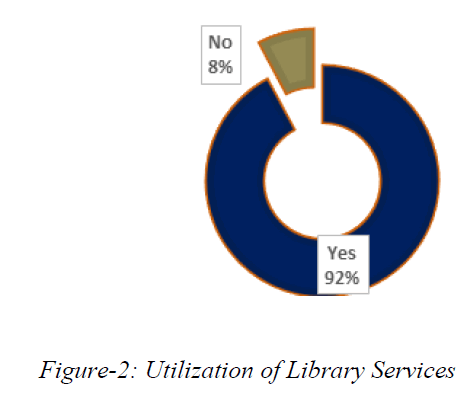
Figure-2: Utilization of Library Services
Satisfaction level of library resources and services
The satisfaction level of the library resources and services depends upon the awareness and usage of the users.
Table 5 and Figure 3 depict that a total of 45 respondents were highly satisfied with library resources, followed by library services (38. More than fifty percent of the users are satisfied with library resources and services. 1.8% of the respondents were highly dissatisfied with library resources and services. This is due to outdated information resources available in the library and a lack of e-resources and digital library facilities. The users opined that poor internet connectivity can hinder the usage of library resources and services available in their library (Table 5 and Figure 3).
| Satisfaction level | Highly satisfied | Satisfied | Neutral | Not satisfied | Highly not satisfied | Total |
|---|---|---|---|---|---|---|
| Library resources | 45(40.9) | 56(50.9) | 4(3.6) | 3(2.7) | 2(1.8) | 110 |
| Library services | 38(34.5) | 58(52.7) | 8(7.3) | 4(3.6) | 2(1.8) | 110 |
Table 5: Satisfaction Level of Library Resources and Services
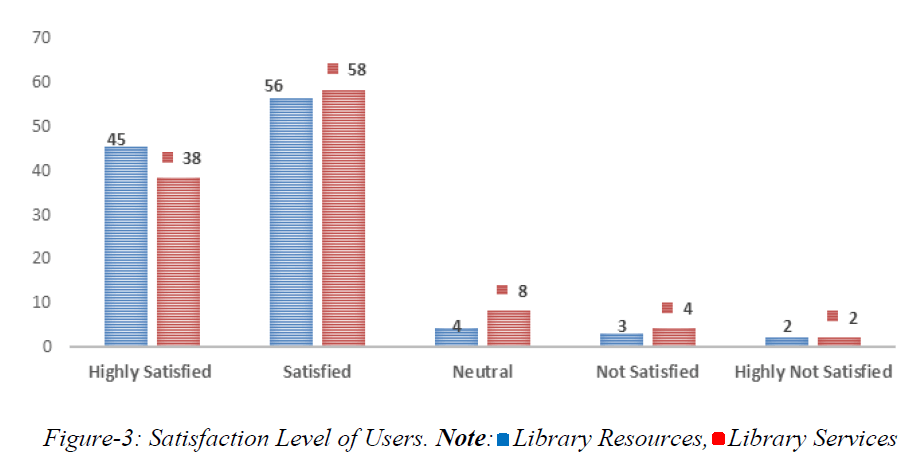
Figure-3: Satisfaction Level of Users. Note: Library Resources,
Library Resources,  Library Services
Library Services
Problems faced by users while using information resources and services
Table 6 depicts the users who face problems while searching and using information resources and services at Poorna Prajna Degree College library. The majority of the respondents have not faced any problems while using the library facilities and services in their college library. But 7.3% of users strongly agreed that inconvenient library timing hinders the proper use of library facilities. So, they suggested that library timings should be extended for better use of library services.
| Problems | Strongly agree | Agree | Neutral | Disagree | Strongly disagree | Total respondents |
|---|---|---|---|---|---|---|
| Inconvenient library timing | 8(7.3) | 9(8.2) | 14(12.7) | 63(57.3) | 16(14.5) | 110 |
| Outdated sources of information | 7(6.4) | 11(10) | 30(27.3) | 50(45.5) | 12(10.9) | 110 |
| Poor internet connectivity | 6(5.5) | 10(9.1) | 25(22.7) | 52(47.2) | 17(15.5) | 110 |
| Lack of skill to search for E-Resources | 2(1.8) | 8(7.2) | 24(21.8) | 59(53.6) | 17(15.5) | 110 |
| Lack of support from library staff | 2(1.8) | 4(3.6) | 16(14.5) | 60(54.5) | 28(25.5) | 110 |
| Scarcity of time | 3(2.7) | 15(13.6) | 21(19.1) | 58(52.7) | 13(11.8) | 110 |
Table 6: Problems Faced while Searching for Information
The table shows that 13.6% of the respondents opined that they don’t have time to access resources available in the library because of far away from their home places. As much as 10% of the respondents responded that because outdated resources are available in the library, they are challenging to prepare for competitive exams and others. So, they suggested that the library should be updated with modern technology and information for better use. Only a few percent of users (9.1%) opined that poor internet connectivity hinders the usage of online resources available in the library.
The table depicts that 53.6% of the respondents do not face any problems regarding using EResources, while 7.2% of the users opined that lack of orientation, they difficult to find the required e-resources in their library. A regular training program will help the users use the library facilities at the maximum level. The table shows that most users (54.5%) opined that library staff are very cooperative and helpful to students and give maximum guidance to use library resources and services. In contrast, 3.6% of the user population is not satisfied with the service and collaboration of library staff. They opined that every student’s presence is essential for the growth and usage of library resources (Table 6).
Need for user education programs
The user education program is essential in libraries for maximum usage of library resources and services. The above figure shows that more than 50% of the users expressed that they do not require user education on the use of library services and facilities (Figure 4).
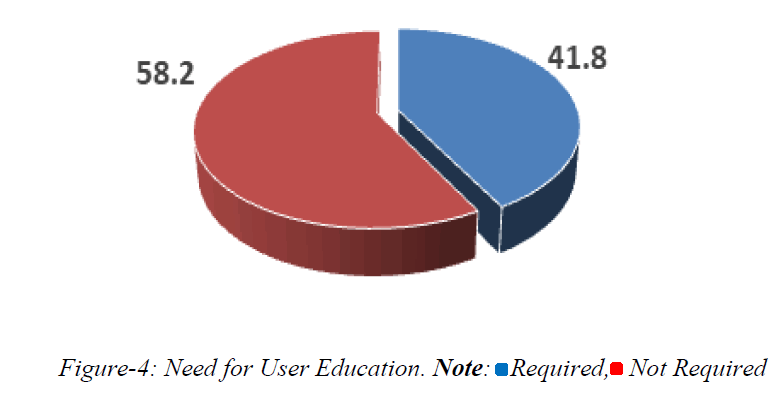
Figure-4: Need for User Education. Note:  Required,
Required,  Not Required
Not Required
Best practices followed by the library
The researcher asked a question about best practices followed by their library. Table 7 shows that 85.5% of the users responded that our college library conducts best practices for the benefit of students. The best practices would familiarize the library resources and facilities, and the students realize about different services available in their library.
| Best practices followed by the library | ||
|---|---|---|
| Description | No. of respondents (Total=110) | Percentage (%) |
| Yes | 94 | 85.5 |
| No | 16 | 14.5 |
| Total | 110 | 100 |
Table 7: Best Practices Followed by Library
Findings of the study
After the analysis and interpretation of data, findings have been framed below;
• Majority (62%) of the postgraduate students are females
• Most of the respondents (98.5%) visit the library to borrow books and other reading materials.
• Lion’s share of the respondents (85%) pursues the assistance of the library staff for locating required information from the library.
• Majority of the users (78.8%) prefer textbooks as essential resources for their study purpose to reference books (50%). The study reveals only a few students (3%) believed that e-resources are important for their academic activities.
• Most of the respondents (92.4%) answered the query that for different purposes they use their library.
• Majority of the respondents agree that they are satisfied with library resources and services. Few students are not happy with library resources and services. The reason behind this is outdated information resources, poor internet connectivity, and inconvenient library timings of the library. Therefore, the management should update library facilities to benefit the students.
• Nearly 7.6% of the students agreed that the lack of skill to search e-resource hindrance the use of digital library facilities available in the library. They suggested regular training programs should be provided to the students about using online resources and N-List facilities available in the library. Very few users agreed that it was impossible to visit the library every day because of inconvenient library timings.
• More than half of the users (58.2%) suggested that regular training programs about library resources and facilities can help the students.
• Lion’s share of the respondents (85.5%) opined that best practices and regular training programs increase the usage of library resources.
Suggestions
Based on this study, the following suggestions are made:
• The users gave more importance to textbooks rather than reference books and online resources. Therefore, the library should provide a correct orientation program to users about the importance of reference books and online resources.
• The study suggests that user satisfaction depends on updated information resources and services, sufficient computers with high-speed internet facilities, and regular information literacy programs.
• Few respondents suggested that librarians should encourage users to use library resources and provide proper guidance to use online resources. Therefore, this is the first duty of the librarians to organize information literacy programs for users and train them for better usage of library resources
Conclusion
A well-equipped and well-managed library and information center are the stepping stone of the modern education system. The college library's infrastructure facilities, information sources, and services can be advanced and developed from time to time. The respondents considered textbooks, newspapers/magazines, and online journals the most important information resources for their study purposes. The users should be made familiar with e-resources for the optimum utilization of library resources. Thus, a survey conducted on the use of library resources by postgraduate commerce students in Poorna Prajna Degree college library Udupi reveals that the college libraries should conduct user education programs at regular intervals for the users to cope-up with the changing information needs and enhance the usability and awareness of the facilities available in the library.
References
- Chayal, Kesar, and Lalita Vatta. "Assessment of information seeking behaviour of post graduate students regarding library resources."
- De Groote, Sandra, and Jung Mi Scoulas. "Impact of COVID-19 on the use of the academic library." Ref Serv Rev (2021).
- Kaur, Kulveen, and Kiran Kathuria. "Assessment of students-faculty satisfaction: a case study of punjab agricultural university library facilities." Desidoc J Libr Inf Technol 42.4 (2022).
- Kumari, Adithya, M. Mahadevamurthy, and Manu Kumar KM. "Utilization of information resources and services by students of B. Ed. College libraries in Mysore: A study."
- Kaushamalika, P. K. M., and W. R. W. M. A. U. Weerakoon. "Students’ satisfaction with library services and facilities at three regional center libraries of the Open University of Sri Lanka." Journal of the University Librarians Association of Sri Lanka 23.1 (2020): 37-56.
- Lakshmi, N. Hari, and K. Surendra Babu. "Use of library sources and services among mca students in Sri Venkateswara University, Tirupati."
- Naik, KG Jayarama. "Use of library resources and services by the pg students: a case study of Bangalore University Library, Bengaluru." (2020).
- Ningoji, Shri Manjunath M., and N. Sadashivappa. "user satisfaction on library resources, facilities and services: A case study in Shri Kumareshwara B. Ed college, Hangal, Dist: Haveri (Karnataka)." Int J Lib Inf Stud 10.3 (2020).
- Naik, M. N., and Lohar, M. "The perspective of library resource and services and its use pattern in government First Grade College, Honnali, Davanagere District : A Study." 9(2), 1–4 (2019).
- Partap, Bhanu, and Manju Ranga. "Awareness and use of e-resources at Chandigarh College of Architecture, Chandigarh, India: A Study." (2021).
Author Info
C. Prema1*2Department of Library, University of Sahyadri Arts College, Shivamogga, Karnataka 577203, India
Received: 13-Oct-2022, Manuscript No. IJLIS-22-77150; Editor assigned: 17-Oct-2022, Pre QC No. IJLIS-22-77150(PQ); Reviewed: 08-Nov-2022, QC No. IJLIS-22-77150; Revised: 15-Nov-2022, Manuscript No. IJLIS-22-77150(R); Published: 22-Dec-2022, DOI: 10.35248/2231-4911.22.12.839
Copyright: This is an open access article distributed under the terms of the Creative Commons Attribution License, which permits unrestricted use, distribution, and reproduction in any medium, provided the original work is properly cited.
Call for Papers
Authors can contribute papers on
What is Your ORCID
Register for the persistent digital identifier that distinguishes you from every other researcher.
Social Bookmarking
Know Your Citation Style
American Psychological Association (APA)
Modern Language Association (MLA)
American Anthropological Association (AAA)
Society for American Archaeology
American Antiquity Citation Style
American Medical Association (AMA)
American Political Science Association(APSA)



